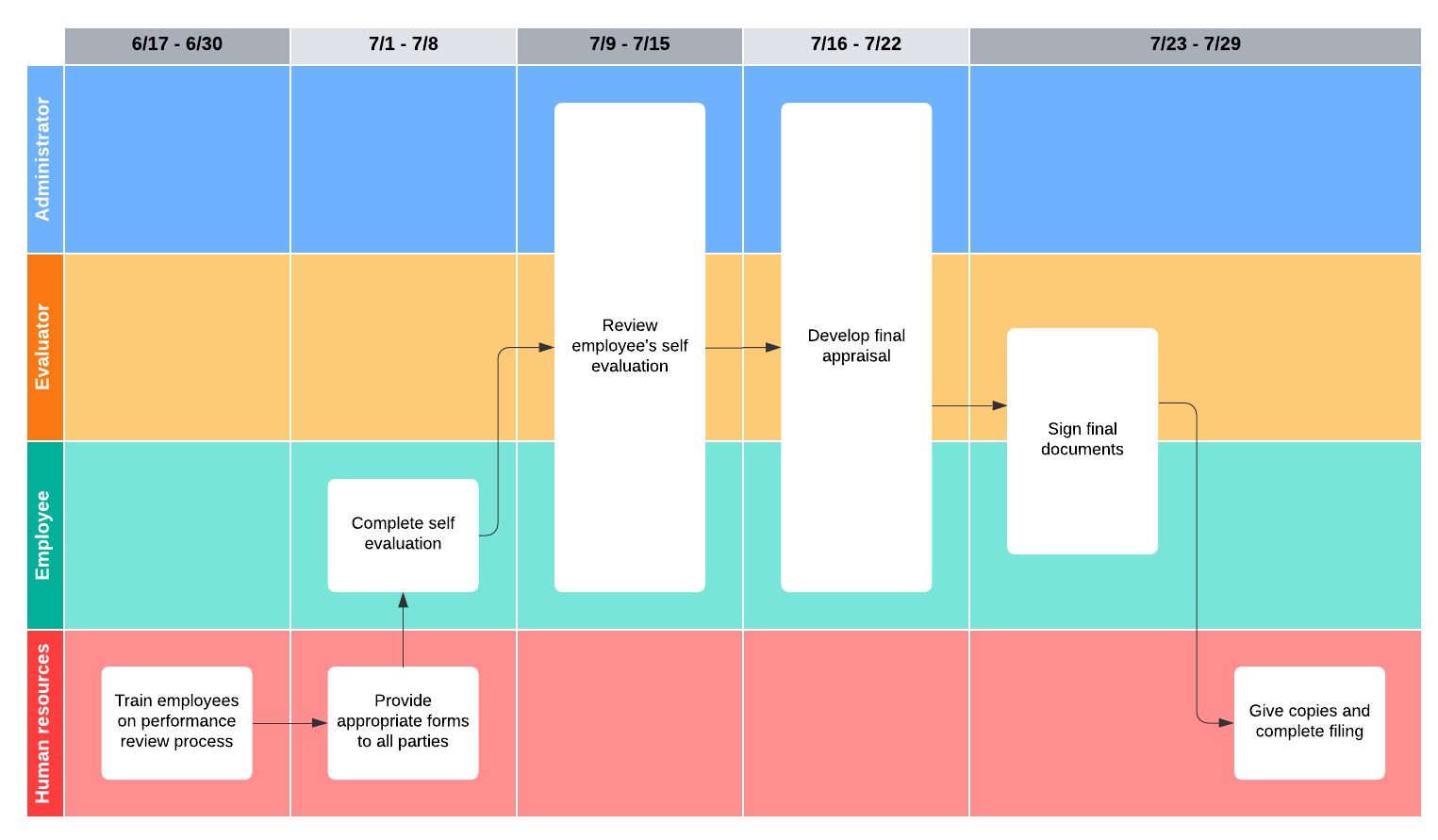
6 steps to enhance your employee review process
Lucid Content
Reading time: about 7 min
Topics:
What is the employee review process?
The employee review process should address concerns and feedback and offer both short and long-term goals. The review process can help to determine salary adjustments, track whether or not progress was made, and address problems.
Whether you’re a manager or one of your organization’s sterling HR representatives, you’re probably more anxious about the annual employee performance review process than your employees are. In fact, managers spend 210 hours a year on performance review process best practices.
What many managers sometimes fail to realize is that the employee review process doesn’t have to be the stereotypical typified, stale, and potentially awkward (or difficult) conversation that it has typically been. We’ve created an actionable list of the best practices so that both you and your direct reports can maximize the time spent on reviews and better manage and motivate your talent.
Benefits of employee reviews
Employee reviews are more than just a once-a-year meeting to go over an individual's performance. There are advantages to these annual reviews that will impact your team members long after the meeting is over:
- Improved communication
- Employee engagement
- Professional development
- Skills growth
Steps in the employee review process
1. Determine which type of performance review process your company should use
Management should create a safe space for direct reports to have conversations with managers—as opposed to an authority-driven space where a manager just tells each employee where they’re failing and why. Businesses should get into the habit of coaching their direct reports instead of disciplining them, and they might also want to think about implementing a management feedback system to balance the scales and better facilitate feedback between employees and managers.
Let’s look at the different review processes you can do to achieve this.
Types of employee review processes
Top-down
This approach is typically what you would envision for a standard employee performance review. A top-down review involves a supervisor formally meeting with the supervisee to discuss mistakes and insights and provide constructive feedback.
The goal is to open communication between employees and supervisors to review past performance and plan for future professional development. But a major critique of the top-down approach is that it can cause employees anxiety and hinder open communication because it is centered around an unbalanced relationship between managers and employees.
Self-evaluation
Just as the name suggests, self-evaluations involve employees reviewing their performance both with qualitative and quantitative measurements. This approach grants employees more ownership in the process, giving them the opportunity to reflect on their work and providing managers with valuable insights from the employee's perspective.
However, self-assessments often lack objectivity and skew the employee perspective, which can easily lead to conflict and employee resentment.
360-degree
Also known as the multi-rater feedback or multi-source feedback, the 360-degree approach aims to provide a comprehensive employee assessment. It incorporates feedback from numerous parties, including peers, direct reports, non-direct supervisors, and even the employees themselves. While the 360-degree feedback process offers more robust and constructive feedback, it can also overwhelm employees and require more time to process all of the information.
Ratings
A performance rating evaluation uses a scale or grading system usually customized for your organization to measure employee's performance. A key benefit of a performance evaluation rating scale is that it provides quantifiable data and can easily show trends over time. However, most rating systems often lack nuance and tend to skew nice rather than accurate.
Mix and match
Combine any of the review processes listed above to find the best employee performance review system for your organization.
2. Map out your employee review process
Once you’ve determined the performance review process for your organization, the next step is to map the entire process to get everyone on the same page.
The complexity of your process will depend largely on the method you chose above. A rating system is much more straightforward than using the 360-degree feedback, which requires you to bring together multiple parties.
Typically building out the process starts with HR determining the timeline and steps needed to execute a successful employee performance evaluation. Be sure to consider the following when you start mapping out your own employee review process:
-
Training: Determine whether employees need to be trained on the process, especially if it is new to the organization.
-
Time: Consider how long will employees and managers need to complete the assessment.
-
Feedback and action: Include when employees will receive feedback and the timeline for any action that needs to be taken as a result of the evaluation (e.g., promotions, pay increases).
-
Participants: Decide how many individuals are involved. Is it simply the manager and employee or does the process include multiple evaluators like in the 360-degree feedback method?

3. Ask employees to complete self-evaluations and managers to evaluate each employee
Most employees don’t like performance reviews because they seem completely out of their control. To make them feel more involved in the process and the outcome, have employees complete a self-assessment. This assessment gives employees the opportunity to share their perspectives on their own experience and growth. Encouraging self-reflection even motivates employees to focus on their careers and achieve professional goals.
More importantly, self-evaluations grant managers insight into their employees' experiences that they might be unaware of. For example, supervisors may learn if an employee is struggling with a particular task or even if they led a successful project. Now managers can complete a comprehensive assessment that provides accurate and actionable feedback for employees.
4. Hold a performance calibration meeting
A persistent challenge of the performance review process is ensuring that employees are reviewed accurately and fairly against the same standards. This is where a performance calibration comes in. Performance calibration meetings bring together managers to determine and agree upon the criteria for high, average, and low performers and evaluate employees appropriately.

See all of the steps involved to get started with performance calibration.
Learn more5. Deliver the employee review and actualize goals and impediments
Delivering the review is the most important part of the entire employee performance review process. It establishes employees' goals, attitude, and motivation for the next year. Make sure employees are prepared for the meeting. Don’t keep them in the dark so that issues snowball and the conversation becomes awkward and painful. Instead prepare a template that managers and employees can fill out before the meeting so that they go into the review with very clear expectations.
Start the review by recognizing the employee's accomplishments and efforts from the past year. Nearly 70% of employees report they would work harder if they felt that their efforts were recognized. More than that, if employees are doing something that is beneficial to the organization and their career, they should know to keep doing that.
From there, transition into constructive feedback on how employees can improve. 92% of employees agree that if constructive feedback were delivered to them appropriately, it would help motivate them to improve their performance. Coach employees and use the review to set clear attainable SMART goals to help employees become successful.
6. Maintain communication after the evaluation is completed
Communication doesn’t stop once the formal review is finished—instead, managers should regularly meet one on one with employees to continue giving feedback and check progress. During the review process, successful managers should evaluate their current communication style and methods. It may surprise you to hear that 76% of all employees want feedback at least monthly. With that fact in mind, get in the practice of holding weekly or bi-monthly one-on-ones with each of your direct reports.
By having regular contact and communication, you can ensure that expectations are being met and that you are maintaining a regular review process consistent with your culture. Additionally, these check-ins will give you the chance to coach your employees along the way instead of having potentially painful conversations at the end of each quarter.
In fact, some employers create weekly templates for their one-on-ones where employees discuss what’s working well, what’s not, and what their short and long-term goals are. Each of these methods will help ensure performance review process best practices. Holding these regular, informal meetings will help build the conversation so that when the time comes for your formal review process, there will be no surprises in regards to employee appraisal.
It’s no wonder that the majority of all international organizations are reinventing their current employee review processes. But more inspiring is the fact that it actually works: 96% of employees across multiple dozens of organizations report that receiving specific, continuous performance feedback is helpful. Revamp your employee performance review process today so your organization can continue to innovate for the future.

Use our template to get started today with mapping out your organization’s employee performance evaluation process.
Try it in LucidchartAbout Lucidchart
Lucidchart, a cloud-based intelligent diagramming application, is a core component of Lucid Software's Visual Collaboration Suite. This intuitive, cloud-based solution empowers teams to collaborate in real-time to build flowcharts, mockups, UML diagrams, customer journey maps, and more. Lucidchart propels teams forward to build the future faster. Lucid is proud to serve top businesses around the world, including customers such as Google, GE, and NBC Universal, and 99% of the Fortune 500. Lucid partners with industry leaders, including Google, Atlassian, and Microsoft. Since its founding, Lucid has received numerous awards for its products, business, and workplace culture. For more information, visit lucidchart.com.
Related articles
Aligning human resources and business strategy
Few departments have a better bird’s-eye view of the entire organization than human resources. Learn what part human resources plays in the strategic planning process and how HR professionals can align their goals with the overall company strategy.
4 steps to strategic human resource planning
Many CEOs believe that their employees are the most important factor in their company’s economic success, so if you want to succeed, find and keep the best talent. Learn how to develop your strategic human resource plan.
What does HR actually do? 11 key responsibilities
Everyone knows that HR is an important department in your organization, but few employees know why. Read our in-depth description of what the HR department does (or what they should be doing) to meet the needs of employees.
